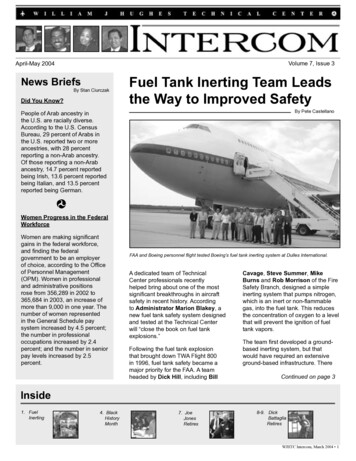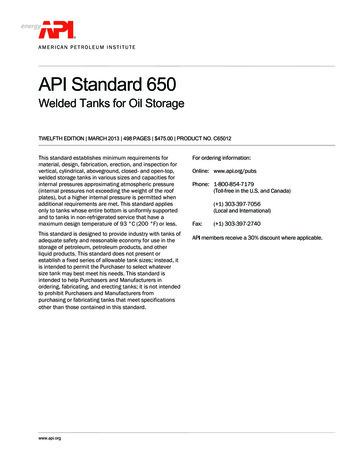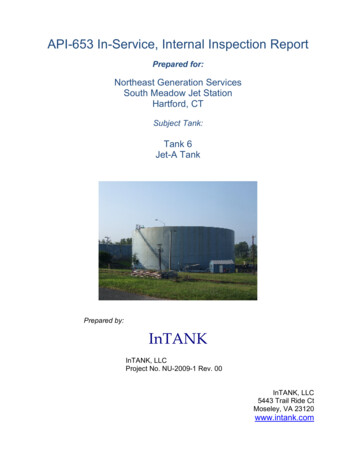
Transcription
Volume 7, Issue 3April-May 2004News BriefsBy Stan CiurczakDid You Know?Fuel Tank Inerting Team Leadsthe Way to Improved SafetyBy Pete CastellanoPeople of Arab ancestry inthe U.S. are racially diverse.According to the U.S. CensusBureau, 29 percent of Arabs inthe U.S. reported two or moreancestries, with 28 percentreporting a non-Arab ancestry.Of those reporting a non-Arabancestry, 14.7 percent reportedbeing Irish, 13.6 percent reportedbeing Italian, and 13.5 percentreported being German.Women Progress in the FederalWorkforceWomen are making significantgains in the federal workforce,and finding the federalgovernment to be an employerof choice, according to the Officeof Personnel Management(OPM). Women in professionaland administrative positionsrose from 356,289 in 2002 to365,684 in 2003, an increase ofmore than 9,000 in one year. Thenumber of women representedin the General Schedule paysystem increased by 4.5 percent;the number in professionaloccupations increased by 2.4percent; and the number in seniorpay levels increased by 2.5percent.FAA and Boeing personnel flight tested Boeing’s fuel tank inerting system at Dulles International.A dedicated team of TechnicalCenter professionals recentlyhelped bring about one of the mostsignificant breakthroughs in aircraftsafety in recent history. Accordingto Administrator Marion Blakey, anew fuel tank safety system designedand tested at the Technical Centerwill “close the book on fuel tankexplosions.”Following the fuel tank explosionthat brought down TWA Flight 800in 1996, fuel tank safety became amajor priority for the FAA. A teamheaded by Dick Hill, including BillCavage, Steve Summer, MikeBurns and Rob Morrison of the FireSafety Branch, designed a simpleinerting system that pumps nitrogen,which is an inert or non-flammablegas, into the fuel tank. This reducesthe concentration of oxygen to a levelthat will prevent the ignition of fueltank vapors.The team first developed a groundbased inerting system, but thatwould have required an extensiveground-based infrastructure. ThereContinued on page 3Inside1. FuelInerting4. BlackHistoryMonth7. JoeJonesRetires8-9. DickBattagliaRetiresWJHTC Intercom, March 2004 1
Russ Chew Speaks at ATCA Symposium in Atlantic CityBy Pete CastellanoOn March 31, FAA Air TrafficOrganization (ATO) Chief OperatingOfficer Russ Chew presentedremarks, as part of a paneldiscussion entitled “ATO Operations”,at the Air Traffic Control Association’s(ATCA) Technical Symposium. Theconference was held on March 3031 at the Sheraton Hotel in AtlanticCity, and technical demonstrationswere held at the William J. HughesTechnical Center. Dr. Chew andtwo other ATO chief executivesdiscussed the challenges of runninga performance-based organization(PBO).of NAV CANADA spoke on theCanadian ATO, a private, non-profitentity. Officers, or “members”, asthey are called, serve as a board ofdirectors. The government retainsthe safety and regulatory functions.This privatization effort required asimilar culture change, focusing onperformance and customer service.Dieter Kaden, chief executive officerof DFS, the German air trafficorganization, spoke about the airtraffic function that was privatizedin Germany in 1993, including bothcivilian and military operations.DFS is a for-profit entity, whereshareholders earn revenue on theirinvestment. The greatest challengeMr. Kaden has faced was moving theorganization from one that is processdriven, to one that is driven byperformance and customer service.Dr. Chew spoke about the newFAA ATO, which is a PerformanceBased Organization (PBO) withinthe Federal government. Dr. Chewbelieves that the dedication of ATOemployees to public service is one ofits greatest strengths. However, hebelieves there are many challengesahead. The organization is in theprocess of realignment, with serviceto customers being the driving force,accompanied by meaningful costaccounting and controls. While safetyremains the primary mission of theATO, allowing for increased capacityis our next important priority becausepassengers are projected to increase4% per year over the next ten years,leading to 1.1 billion passengers peryear.John Crichton, President and CEOMeeting customer needs for moreDr. Russ Chewcapacity will be achieved througha combination of initiatives. The airtraffic control system must be bettermanaged, and new Terminal RadarApproach Controls (TRACONs) andweather systems must come on line.While more flights could mean morerevenue to the aviation trust fund,many factors, including more flightsat lower ticket prices, could work tohave the opposite effect.FAA Administrator’s Award WinnersBy Stan CiurczakThe Technical Center recently hadseveral winners of the prestigiousAdministrator’s Award for Excellencein EEO, Affirmative Employmentand Diversity. Congratulations to thefollowing Technical Center employeesfor a contributing to a climate thatbenefits us all:Managing DiversityIndividual TeamTechnical Center Diversity Council 2 WJHTC Intercom, April-May 2004John Lapointe, Airport andAircraft Safety DivisionRaymond Stover, Office ofStrategies Human Capital Edwin Mack, InformationTechnology Division jennelle Derrickson, Airportand Aircraft Safety Division Rosanne Weiss, Airport andAircraft Safety Division Paul Lawrence, FacilitiesServices and EngineeringDivisionContinued on page 3
Fuel Tank Inerting Team Leads the Way to Improved SafetyContinued from coveralso was the problem of coming upwith a system that would be simple,lightweight and cost-effective. Theteam, worked closely with FAA ChiefScientist and Technical Advisorfor Fuel System Safety, IvorThomas, to develop a lightweighton-board system. With no movingparts, the onboard system is bothsimple and relatively inexpensive,making it easier to field in the nearterm. Based on demonstrations bythe team, Boeing made a unilateraldecision to install inerting systemsin production airplanes starting in2005. Airbus decided to flight test theequipment and last summer the teamhelped Airbus conduct the flight testsduring the extraordinary heat wavethat hit France in August. Their testscorroborated the effectiveness andpracticality of the FAA system.Administrator Blakey announcedon February 17 that the FAA isconsidering a Notice of ProposedRulemaking requiring that thenew system be installed on 3800Boeing and Airbus models whose airconditioning systems could causeheating of center-wing fuel tanks. Theannouncement made by AdministratorBlakey was a direct result of theexcellent scientific work of our ownteam at the Technical Center!Dick Hill, left, Dave Bilcock, an Airbus engineer, center, and Mike Burns, right, in the Airbus A320during last summer’s flight tests of the FAA inerting system.FAA Administrator’s Award WinnersContinued from page 2 Ken Beisel, Acquisition,Materiel and Grants Division Clifton Baldwin, SystemEngineering Division Baxter Stretcher, VerificationServices Division Brian Colamosca, SystemAnalysis Division Beverly Hite, Real andVirtual Environment Division Joseph Richie, SystemAnalysis DivisionDiversity Council Team Award WinnersContinued on page 10WJHTC Intercom, April-May 2004 3
Black History Month 2004: “The Long Walk To Freedom”By Maudie M. PowellThe month of February was AfroAmerican (Black) History Month, atime that reflected on the period inUnited States history when Americanmen and women of African descentwere relegated to second-classcitizenship. It also recognizes theachievements of current day citizens.Credit for the observance is givento Dr. Carter Godwin Woodson,who had to put farm work ahead ofhis education, but persevered untilhe was able to graduate from highschool at age 21. He continueduntil he received a Ph. D. in historyfrom Harvard University in 1912. Heauthored more than 18 books anddozens of other literary materials inthe study of Afro-American life, layingthe foundation for his progenitors tofollow.In the tradition of Dr. Woodson,the William J. Hughes TechnicalCenter commemorated AfroAmerican (Black) History Monthwith events that educated, inspired,and entertained employees,students and the community. Thisyear’s theme, “The Long Walk toFreedom,” encapsulated the diverseexperiences of African Americansin this nation. Each planned eventdistinctly highlighted the manygreat contributions made by AfricanAmericans and the great turmoilAfrican American men, women, andchildren painfully endured to makethis nation great.The primary opening event onFebruary 12 was presented in twocreative and dramatic components.Under the direction of Ralph E.Hunter, Sr., founder and curator of theAfrican American Heritage Museumof Southern New Jersey, an exhibitionof “Plantation Sketches” by the latepainter, J. Philip Campbell, weredisplayed throughout the month in theatrium. As in pre-radio and-televisiondays, storyteller Michelle Washington4 WJHTC Intercom, April-May 2004The audience watched a reenactment of Brown v. Board of Education where the NAACP Legal Defense Team led by Thurgood Marshall and portrayed by Al Jefferson (second from right) and the SouthCarolina School Board Legal Team led by Charles Davis and portrayed by Jay Fox (far right) argued“separate but equal”. Pete Castellano (middle), Stan Ciurczak (second from left) and Rich Mendell(left) portrayed Supreme Court Justices.Wilson dazzled the audience withrural folklores and song.Of the many remarkable occurrencesof the 20th Century, the changes inthe social and economic status ofAfrican Americans is certainly one.Videographer, Cecil L. Callender, Jr.,HOST Support Branch, presentedthe award-winning documentary film,“Eyes on the Prize,” and led viewerson a re-discovery of Americanhistory. In this film, the late filmmaker,Henry Hampton, “ placed in real-timethe lives of many courageous peoplewho sacrificed their personal well-beingto bring about change in laws andchange in the minds of people who,for a long time, had subjugatedpeople of color to some harshrealities of life.” Cecil Callender’s“Brown Bag Café and Cinema” andthe fresh popcorn he served weretrue learning experiences and treatsfor all who came every Tuesday andThursday to watch on the big screenin the Atrium.At the Technical Center, like manyother institutions and organizationsaround the nation, programscommemorating the 50th anniversaryof the historic Supreme Court case,Brown v. Board of Education, werepresented. The audience, whichincluded many children from areaschools, witnessed the brilliant workand resolve of a true legal engineer,Charles Hamilton Houston, whowon unprecedented legal cases thattore down the wall of segregation ineducation in the state of Maryland.As shown in the award-winningdocumentary, “The Road to Brown,”Charles Hamilton Houston was thearchitect of, and laid the groundworkContinued on page 5
Black History Month 2004: “The Long Walk To Freedom”Continued from page 4for, future legal cases thatsuccessfully argued against separateeducational systems in this country.Following the film, the audienceattentively watched an enactmentof a courtroom scene in the case,Brown v. Board of Education, wherethe NAACP legal defense team, ledby Thurgood Marshall and portrayedby Al Jefferson, and the State ofSouth Carolina School Board legalteam, led by Charles Davis enactedby Jay Fox argued the merits of the“separate but equal” law before theSupreme Court of the United States.Pete Castellano, Stan Ciurczak andRich Mendell portrayed the justicesof the Supreme Court. The rest, asyou know, is history.The tireless resolve of the TechnicalCenter’s Black History MonthPlanning Committee, under thedirection of Patricia D. King, madethis month-long presentation possible.“Soul Food” was served after the program commemorating the 50th Anniversary of the historic caseBrown v. Board of Education.Thanks go out for the diligent effortsof the committee: Cecil Callender,Bessie Johnson, Stacie Graves,Kenneth Hitchens, ThomasenaBrown, Samuel Wilson, MaudiePowell, Latasha Reddick, ChinitaRoundtree-Coleman, Al Jefferson,Jay Fox, and Ray Stover; and thehelp of others like Verna Artis, CarolHewitt, Willy Bridges, RonaldHeist, Holly Baker, Ken Beisel,Annette Harrell, Carl Genna, LanaHaug, Anna Kertz, Bobby Nichols,and many more who contributedto making this year’s programs asuccess and educational experience.Words of gratitude are extended toDr. Anne Harlan, Technical CenterDirector, and all management stafffor allowing Center employees theopportunity to present and attendthe events. Appreciation also isextended to the local schools andcommunity leaders who attendedvarious programs. In summary, theseactivities combined with the “SoulFood” that was served after the reenactment to nourish our bodies andminds as a diverse workforce.Lana Haug (left) and Leona Wilkes (right) at the 2004 Black History Month festivities.WJHTC Intercom, April-May 2004 5
FAA Corporate Mentoring Program is UnderwayBy Faith AwadThe Corporate Mentoring Programis a web-based online mentoringprogram that supports the FAA FlightPlan’s Organizational Excellenceinitiative. The automated programwill facilitate the management ofthe FAA’s entire mentoring process,regionally and globally with 24/7accessibility via the Internet for allparticipating employees.first step in the pilot phase of theCorporate Mentoring Program hasbeen completed and the responsewas overwhelming. Employeesselected to participate in the pilotphase of the program will be notifiedand expected to begin the program inearly April. There is a start-up fee of 35.40 per employee, which coversthe system maintenance fees.The Office of Civil Rights launchedthe pilot phase registration for theCorporate Mentoring Program. Thepilot phase began on March 5. TheThe pilot phase will last six months.After the program is completed andevaluated, the program graduallywill be expanded to all employeeswho wish to participate and have thesupport of their organization.To learn more about the program, visitthe Corporate Mentoring Programpage at http://mentoring.colaboro.wsor contact one of the localcoordinators at the Technical Center:Lana Haug, 485-4285, CarolynPokres, 485-8944, Faith Awad,485-6675, Pat Maier, 485-4669, andJamaal Lipscomb, 485-7812.U.S. Representatives Mica and LoBiondo Tour TSA LabsBy Pete CastellanoTechnical Center for the purpose oftouring the Transportation SecurityAdministration (TSA) laboratories.They were given a private tour thatincluded access to cutting-edgesecurity technology in various stagesof development, much of it classified.U.S. Representative John Mica (R-FL), flankedby Representative Frank LoBiondo (R-NJ),speaks to reporters during their visit to theCenter on March 29.On March 29, U.S. RepresentativesJohn Mica (R-FL), and FrankLoBiondo (R-NJ) visited the6 WJHTC Intercom, April-May 2004Following their tour, RepresentativesMica and LoBiondo held a pressconference in the TechnicalBuilding Atrium. Both men praisedthe excellent work being doneat the Center in the security andsafety areas. They pledged thatCongress would continue toprovide the appropriate fundingfor Center projects and programs.Representative Mica did expressconcern, however, that Congresshad used some of the past fundingthat was earmarked specificallyfor security technology for otherpurposes, such as salary expensesfor baggage screeners. Theypledged to ensure that the 150million contained in the currentDOT reauthorization will go towardsdeveloping and deploying securitytechnology that will help deter futureterrorist attacks.Referencing the terrorist attacks ofSeptember 11, 2001, Mica notedthat the effects of another aviationbased attack would be absolutelydevastating, not only for the country,but also for the economy in general,and for the aviation industry inparticular. “We can’t afford to fail,”Mica said, just as the aviation industryis entering a period of recovery from9/11. Both Mica and LoBiondo werevery pleased with the work beingperformed in the Technical Center’slabs, and they want to ensure that theproper attention, focus, and resourcesremain devoted to developing newsecurity technology and deploying itto the field, as quickly as possible.
Employee Profile:“Mr. NJ” Bodybuilding Works at the Tech CenterBy Barbara Harris-ParaI guess many of us had no ideathat we had such a famous personworking here. His name is LamarCorbitt, and the National AmateurBodybuilders Association (NABBA)named him winner of the Mr. NewJersey bodybuilding contest the pasttwo years in a row. Doing this was noeasy feat.It took Lamar years of training,beginning with wrestling in the 135-lb.class at Egg Harbor Township HighSchool, continuing through to liftingweights and, finally, bodybuilding.These sports led Lamar to “powerlifting,” which helped him toachieve the title of Mr. New Jerseybodybuilder after just a few years ofcompetition, at the age of 30.Lamar’s schedule would make mostof us cringe. He is up at 4:30 a.m. sohe can get to the gym before work.He puts in a full day as an electricalengineer at the Technical Center, andthen goes back to the gym to work asa trainer until 6:30 p.m. Once he getshome he has dinner, spends sometime with his wife and young son, andgoes to sleep by 8:30 p.m.Eventually, Lamar hopes to competein the national bodybuilding contests,which are held in Harrisburg, PA.His biggest dream is to go to the Mr.Universe contest, which will requirea lot of work on his part, but alsopresents huge sponsorships.Developing one’s physique is verytime consuming, says Lamar. “I didn’tget the 42” chest, 29” waist withbiceps that are about 15 1 2” aroundwithout a lot of dedicated work”. Foodand diet also play a big role as herefuses to use any steroids or drugsto attain his physique.Lamar learned bodybuilding thehard way, by trial and error. The bestadvice he has for others who areLamar Corbitt, the National AmateurBodybuilders Association (NABBA) winner ofthe Mr. New Jersey bodybuilding contestinterested in bodybuilding is, “Don’tbe afraid to ask for help”. Lamarindicated that he liked “changingpeople’s lives for the better.”42 Years of PublicServiceJoe Jones (far right) retired fromthe FAA on May 1st. A few yearsago he and Dave Maslanka hadthe opportunity to meet formerPresident Bill Clinton outside theFAA hangar.WJHTC Intercom, April-May 2004 7
Dick Battaglia Retires after 43 Years of Public ServiceBy Stan CiurczakRichard (Dick) Battaglia, theenterprise security manager for theFAA William J. Hughes TechnicalCenter, retired on May 3, from theFAA after 43 years of public service.This includes 8 years in the militaryand 35 years in the FAA.Dick is a licensed commercialpilot, and a licensed aircraft enginemechanic. He joined the U.S. Navyin 1959 as a flight engineer. UncleSam assigned him to antisubmarinewarfare duty during the Cuban MissileCrisis, which required flying 15-hourpatrols. He left the Navy in 1967.He began his career at theFAA National Aviation FacilitiesExperimental Center (NAFEC) asan aircraft and aerospace technician(mechanic) in October 1968. Afterone year, he went to work in theairport operations center, whichoversees airport operations andmaintains communications withCenter management. He became themanager of the Operations Centerin 1987. From that position he waspromoted to the position of head ofenterprise security for the TechnicalCenter.There isn’t anything Dick didn’t likeabout working here. When he passedthrough the gate each morning, hefelt so lucky to work here that he feltlike he should get down and kiss theground. He is proud to have beenassociated with the Tech Center andits employees, where he said heDick Battaglia, right, boarding an F-16 and preparing for takeoff, center. The oldNAFEC flight line below.8 WJHTC Intercom, April-May 2004experienced, “far more good timesthan bad times”.He said he would miss workingin a premier facility that has beeninstrumental in developing many,many aviation accomplishments.“Anytime you get on a plane, you seethings the Center has developed ortested,” he said. Dick said he wouldmiss his friends and the half-hourlunch breaks. He plans to continueworking during his retirement.
WJHTC Intercom, April-May 2004 9
National Cancer Control MonthBy Carole BralskiApril is designated as “NationalCancer Control Month”.In 1938, the United States Congresspassed a joint resolution requestingthat the President issue an annualproclamation declaring the month ofApril as cancer control month. Thus,each year the President of the UnitedStates makes this proclamation tohighlight advances against cancerand rededicate the nation to fightingthis disease.However, for the American CancerSociety (ACS), every month iscancer control month as it worksyear-round to fulfill its mission ofeliminating cancer as a major healthproblem. Cancer control is a broadarray of organized activities at thelocal state, regional or nationallevel that have a positive impacton reducing the human burdenof cancer. Examples of activitiesconducted at ACS include: updatingACS guidelines on various types ofcancers and nutritional information;planning campaigns; conductingtelephone surveys of 11 to 18year-olds and their parents aboutsun exposure activities and sunprotection behaviors; working withAirlifeline, a national organization thatprovides cancer patients with freetransportation to and from medicaltreatment facilities; expanding the “ICan Cope” education program, anddeveloping the ACS Cancer SurvivorsNetwork, a free 24-hour telephonebased information and supportsystem and a web-based system.Healthy behavior can greatly reducethe risk of cancer. To protect againstthis disease, Americans can makesmart choices to improve their healthand reduce the risk of cancer throughdiet and fitness and avoiding the useof tobacco, excessive drinking andexposure to sun. Since 1991, the5-a-Day for Better Health Programhas spread the message that eatingfive or more servings of fruits andvegetables can improve health andthe odds of survival for all ages.In observance of Cancer ControlMonth, the Technical Center heldits annual Blood Chemistry AnalysisScreening in the Center’s cafeteria onApril 14 and April 21, and encouragedall employees to partake in thispreventative health screening.Preventative health screening is vitalto early detection and treatment ofcancer. Screening can detect manyforms of cancer, allowing patients toseek treatment and defeat the cancerbefore it spreads.The Cancer Information Service, afree public service of the NationalCancer Institute (NCI) and theNational Institute of Health,operates as a national resourcefor information pertaining to cancerand can be contacted at 1-800-4CANCER or visit its website at http://www.cancer.gov.FAA Administrator’s Award WinnersContinued from page 3 Gary Graybill, Office ofEnterprise Performance Stacey Hamilton,Maintenance ServicesDivision Stacie Graves, Airport andAircraft Safety Division Vienna Drago, Civil RightsOfficeModel Work EnvironmentEmployee of the YearRosanne Weiss, Airport and AircraftSafety Division10 WJHTC Intercom, April-May 2004John LaPointeRosanne Weiss
May 13 is Asian Pacific Day at the Technical CenterBy Paul TanMay 13 has been designated asAsian Pacific Day 2004 at the FAAWilliam J. Hughes Technical Center.All are invited to come and join thecelebration activities for Asian PacificAmerican Heritage Month.The Asian Pacific American Coalition(APAC) has planned a two-hourprogram in the auditorium, from1 p.m. to 3 p.m., on May 13. Theprogram will include Chinese musicinstruments and music, Indiandances, Korean dances, Japanesedances, and Western musicinstruments and music. Attendees willbe invited to sample Chinese, Indian,Japanese, Korean, Thai, Vietnameseand Singapore foods after theprogram.APAC also has planned an exhibitionin the atrium of scenic pictures of the“River South” region of China in honorof Asian Pacific American HeritageMonth. After the May festivities, APACplans to give away these beautifulpictures.The officers of APAC are:Dr. Paul Tan, PresidentMr. Ayaz Ahmad, Vice PresidentMrs. Cristina Tan, SecretaryMrs. Anny Cheung, TreasurerMr. Rong Wang, Arts DirectorPlease contact Dr. Paul Tan onextension 5-6665 if you have anyquestions on APAC or the celebrationactivities.Brief History of Asian Pacific AmericanHeritage MonthMay is Asian Pacific American(APA) Heritage Month, acelebration of Asians and PacificIslanders in the United States. U.S.Representatives Frank Horton ofNew York and Norman Y. Minetaof California introduced a HouseResolution in 1977 that calledupon the President to proclaimthe first ten days of May as Asian/Pacific Heritage Week. U.S.Senators Daniel Inouye and SparkMatsunaga introduced a similar billin the Senate the following month.Both were passed, and PresidentJimmy Carter signed a JointResolution designating the annualBy Paul Tancelebration in 1978.The holiday was expanded furtherin 1990 when President GeorgeH. W. Bush designated May to beAsian Pacific American HeritageMonth. May was chosen tocommemorate the immigration ofthe first Japanese immigrants to theUnited States in 1843.Currently, there are 60 AsianPacific American ethnic subgroupsrepresenting a vast array oflanguages and cultures. The AsianPacific American ethnic subgroupsare listed in the following table:Asian Pacific American Ethnic ndonesianPapua New GuineanBikini inianKwajalein ayanSolomon IslanderCernamMaldavianSri LankanChineseMariana IslanderTahitianCosmopolitanMarshall IslanderTaiwaneseEniwetok IslanderMarshalleseTarawa ian ganHawai’ianNepaliTrukeseHmongNew Hebrides IslanderVietnameseIndianOkinawanYapeseWJHTC Intercom, April-May 2004 11
Building the International Space StationBy Barbara Harris-ParaA 16-nation coalition has been formedto assemble more than two millionparts into an international spacestation that will be larger than twofootball fields, twenty stories talland will weigh millions of pounds. Itwill generate nearly 120 kilowatts ofelectricity through its solar surfaces.The Wright Brothers taught peoplehow to fly by the seat of their pants,but how would one go about trainingpeople to build a space station andfly in outer space? Astronauts learnhow to assemble items underwaterin order to simulate doing the sameprocedures without gravity. Artificialintelligence activities also are used todevelop hands-on projects.A little more than a year ago, flightswere going to the space station ata rate of 14 per year, but since theColumbia breakup, only the Russianshave made flights to the station. Muchneeded supplies will have to wait untilthe U.S. sends another craft. JackBacon mentioned that the spacestation has a 30 percent chance ofgetting hit by a meteor shower, andits life expectation should be fivetimes that of the Russian Mira.With recent non-manned travelto Mars, and Hubbell telescopepictures of the next galaxy beingbeamed back to earth, will we everuse the space station as it wasfirst designed? Will NASA devise areplacement vehicle for the agingspace shuttles? Will time travel toother galaxies be the next frontier inspace? All these questions and morecannot be addressed until we havea means to get into outer space andback safely.Editor’s Note: Last year thelocal chapter of the IEEE heard apresentation by Dr. Jack Bacon, thegrandson of aviation pioneers DavidL. Bacon and Grace Dunlap. Baconworks at the NASA Johnson SpaceCenter as the systems integrationlead of numerous Russian andAmerican spacecraft. NASA spaceshuttles have been grounded sincethe loss of the Columbia 14 monthsago, leaving the Soyuz missionsand unpiloted Russian Progresscargo ships as the sole way toexchange crews and deliver suppliesto the station. Resident crewswere reduced from three to two toconserve resources, particularlywater, previously carried by shuttles.A mission on April 18 was one of thetwice-yearly taxi flights that take upa fresh Soyuz craft to serve as theemergency lifeboat for the station.The members of the 16-nationpartnership that sponsors the spacestation are considering a Russianproposal to extend missions, from 6months to a year, starting in October.ATO Finance BriefingBy Maudie M. PowellEmployees of FAA organizationsat the William J. Hughes TechnicalCenter learned about the initialfinancial plans and processes thatthe Air Traffic Organization (ATO)currently uses, and proposes to usein the future, as it envisions operatingthe ATO as a commercial business.Members of the ATO Transition Teamfor Finance who visited the TechnicalCenter on March 30 and presenteda 2-hour briefing were: ChristopherReese, former acting vice presidentfor ATO finance and transition leadfor finance; Penny Mefford, actingdirector of finance for planning andanalysis; Rob Tucker, director offinance for capital expenditures; andJohn Rybka, financial team wiringgroup co-lead.12 WJHTC Intercom, April-May 2004Christopher Reese presentedan overview of the ATO FinanceTransition and emphasized thestrong financial focus in the chieffinancial officer position. He said theATO Transition Team for Financehas educated the vice presidents(VPs) on their organization’s missionand assigned resources, and willdevelop at least one metric for eachVP. An initial introduction was maderegarding business planning protocoland integrated planning that drivesbudget requests as new approachesto financing for the ATO. The conceptof “income” above and beyond theTrust Fund is going to be pursued asa new, influential factor that changesjobs in the ATO. Attention will beredirected to “how we spend ourmoney instead of how we get it” withthe focus on expenditures instead ofobligations.The concept of “unit cost data” hasbeen a primary focus for PennyMefford in serving the new ATO. Sheis exploring many financial analysesthat offer integrated information onresou
will "close the book on fuel tank explosions." Following the fuel tank explosion that brought down TWA Flight 800 in 1996, fuel tank safety became a major priority for the FAA. A team headed by Dick Hill, including Bill Cavage, Steve Summer, Mike Burns and Rob Morrison of the Fire Safety Branch, designed a simple










